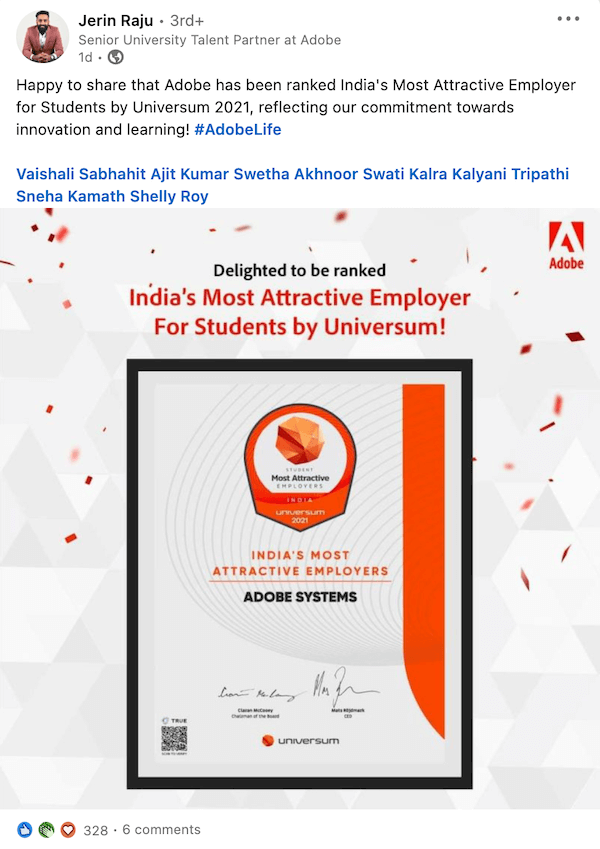Brand. You can’t avoid the term or its numerous variations that exist today.
Think about the different versions out there right now that are pretty common: personal brand, employer brand, internal brand, etc.
These variations are all similar in some ways and may even overlap when it comes to strategy. However, each term has important differences, and they’re all equally important for your organization.
While employee brand is a strategy that might not be a priority compared to the other brand “family members,” it’s become increasingly critical for your company and employees to succeed.
I know, I know. There’s already so much to keep up with and now you have to learn about employee brand!
Let’s dive in.
What Is Employee Branding?
Simply put, employee branding is the process of getting employees on board with the mission, values, and vision of your organization — which motivates them to help convey those messages to customers, stakeholders, prospects, and other employees.
Think of employee branding as the external perception of your organization that’s created by employees and future hires.
Why does this all matter?
Well, the employee voice is 3x more credible than the CEO’s when it comes to talking about working conditions in that company, according to Edelman Trust Barometer.
So if you want to influence how people perceive your organization, you need to get your employees talking about the company — and communicating the kind of employee brand you want.
Employee Branding vs. Employer Branding
But wait a minute, this sounds like employer branding…is it not the same thing? Yes and no.
Employee branding and employer branding do have some overlap when it comes to their definitions and goals. However, they also have some important differences that are worth noting and understanding.
How are they similar?
If you’re familiar with employer branding, then you may have already noticed the similarities. But let’s take a quick look at how these two terms are similar.
Both strategies:
- Influence how your organization is perceived by potential hires.
- Help you attract better talent to boost company results and reduce turnover.
- Influence customers (and potential customers) to be more trusting and excited to work with your company.
How are they different?
Now, the main question you might be asking is, “How do employee branding and employer branding differ?” Below are a few key differences.
- Employer brand is mainly driven by your human resources team and the company executives who guide the direction of the brand, mission, and values.
- Employer branding primarily focuses on work culture, company perks, career advancement opportunities.
- With employee branding, the focus is on the communications and experience employees have with the organization and their work.
- Employee branding is guided by employees’ experience, emphasizing what it’s like to work for the company, how excited employees are about the company, and if these workers are organic brand advocates.
Employer branding, as well as the internal culture, are important to work on and it significantly influences how well your employee brand will do.
While effective strategies for internal work environments are within your control, your employee brand is ultimately created by employees.
Building an Employee Branding Program
Hopefully, the importance of employee branding makes sense to you and your organization already prioritizes it. However, when creating an employee branding strategy it takes time and refinement to truly get it right.
Whether you’re starting from scratch or need a complete reboot of your existing process, here are some tips to help you build an effective employee-branding program.
1. Live and breath your company values
I know, I know. Hearing about company values or mission statements might make you roll your eyes a bit. But it’s critical that every company has a mission statement detailing what they stand for and the values the organization believes in.
If employees don’t know what those are, don’t understand them or, even worse, don’t see leadership practicing what they preach…building an employee brand won’t be easy.
Defining these values and promoting them within the organization is a great first step to building an effective program.
If people in your company don’t know what the organization stands for and believes in, how can they connect to the company, its culture, and its leadership? How will they be your best brand advocates?
Hint: They won’t. So educate employees on your brand!
2. Improve the candidate experience
How often do your human resources and recruiting teams review the candidate experience during interviews and onboarding? Do they even ask employees about that experience?
Maybe your organization consistently does this, but maybe it’s been slacking on this important step.
To build an effective employee branding strategy, you must understand the candidate and employee experience because it has a major impact.
Employees should feel empowered — and trusted — to share their feelings about the brand, both good and bad. Especially the bad.
Create and launch company initiatives designed to help increase employee satisfaction, improve retention, and get people hyped to work for your company.
This makes it easier to recruit top candidates and get outsiders excited about your culture. Plus, employees will be more motivated in their work and become trusted brand advocates.
3. Create consistent employee communications
Communication is important, no doubt, and most organizations generally have some strategy for reaching their employees. But how effective are your organization’s current internal comms?
- 60% of companies don’t have a long-term strategy for their internal communications. (Workforce)
- 74% of employees feel they are missing out on company information and news. (Trade Press Services)
- 72% of employees don’t have a full understanding of the company’s strategy. (IBM)
So yeah, communication is still a struggle.
Your messaging needs to be clear, frequent, and consistent to help spread the company mission, its values, and what its brand is all about.
This is done through a combination of HR activities, developing an employee communication strategy, and implementing technology that employees want to use.
4. Leverage brand training
If you truly want to get your employee branding to the next level, it may require your company to leverage brand training.
Your employees should love to learn; giving them opportunities to not only better their work, but also improve their career trajectory and develop themselves professionally is important.
The reasoning behind some kinds of brand training, like recurring workshops, is to help employees learn how to communicate about the brand and be more effective brand ambassadors.
The truth is, not everyone in your company will be comfortable engaging in either of those activities without undergoing some basic training first. Plus, this kind of education can encourage the more hesitant employees to engage.
5. Utilize the power of social media at work
Social media in the workplace, or employee advocacy, is a powerful strategy that increases the effectiveness of employee branding.
Once your company culture and values are clear, encouraging employees to engage, create, and share about their own work – and the company as a whole – is empowering. It not only helps employees feel trusted and excited, but it can also positively influence their colleagues.
Additionally, these social posts help attract top talent and motivate employees’ networks to apply for open positions. After all, some of the best hires are employee referrals!
Using social at work can also influence marketing and sales, too.
People want to work with and for brands that care about their people and have a great work environment.
Just imagine a few hundred or thousand employees sharing about their work, the company, and its culture — that gets your employee brand in front of countless people.
6. Employee feedback is critical to utilize
Building a great employee brand won’t happen unless you take feedback from your people seriously. They have the best insights and the most relevant experience of what it’s like to work for the company, so their thoughts on mission or values are critical.
Executives, brand managers, and communication teams are often too close to the strategy and may overlook things that could make a HUGE difference in results.
Here are a few things you can do to get a feel for how employees feel about the company: read review sites like Glassdoor or Comparably to see what employees are saying, survey your employees, and encourage open dialogue among managers and their teams.
Whether the feedback you receive is good or bad, you want to gather as much intel to help build a strong employee brand.
7. Harness technology to keep employees connected
Building an employee brand also requires using the right technology that empowers employees through information and facilitates spreading brand messages more easily.
And there’s no shortage of software and products to choose from.
Naturally, there’s no single option that’s best for your organization, as it depends on what you want to achieve. However, the items outlined below are important to all companies in some way.
- Employee engagement software: Employee engagement software helps organizations solicit and track specific feedback from their employees, easily recognize employee achievements, and promote positive activity around the culture. It’s a great way to create brand advocates and boost sentiment.
- Employee advocacy software: Employee advocacy software enables your company to engage its workforce to share branded content and information via social channels. It also helps you reach employees with targeted messaging and information.
- Survey Tools: Survey software allows users to create online surveys, quizzes, polls, and other web forms to gather intel from employees, customers, or general audiences. This is an effective way to create engaging survey content and gather feedback to improve the employee branding strategy.
Employee Branding Examples
Before ending this post, I wanted to ensure you have some excellent examples of employee branding from companies that dedicate significant resources and time to the topic.
Their employee branding efforts give them an edge in their markets and also make them highly desirable to potential job candidates.
Even with this brand sentiment, these organizations still continually work on initiatives and solicit feedback to better create true enthusiasm and word of mouth.
The search engine giant has built a very strong employee brand, which shines through on its about page. On it, you’ll find everything you need to know about Google’s mission and values and its commitment to users, as well as employee stories.
This already sets a tone of excitement for the value Google brings both its workforce and the world at large. But Google goes a step further on its careers page, highlighting everything from diversity and inclusion commitments to its hiring process.

These dedicated landing pages and their transparency allow Google to set the tone for its employee brand and attract the best employees.
Zappos
The well-known online retail company has built a strong employer brand and focuses on its employee branding strategy to attract and retain top talent. How does it do this currently?
Well, one way is to follow @ZapposCulture on Twitter and Instagram, which allows audiences to see more about the work culture and employees. It’s a simple way to get future employees and fans interested in the company from day one.
But showcasing company culture to the outside world is only one thing your brand needs to do. You still need an internal employee branding strategy.
That’s why, similar to Google, the Zappos team works diligently to educate employees and get them to share their experiences. You can find these examples on their careers page here.
Adobe
Beyond building a great culture, another way to establish strong employee branding is to get employees involved in a social-sharing program.
Adobe has more than 900 employee advocates helping spread the message about the company, its products, and what it’s like to work for the organization.
And what kind of reach do those employees have? Over 3 million+ additional connections seeing content shared and created by Adobe employees.
You can follow their branded hashtag #AdobeLife on the major social channels to see a flood of content from employees, all sharing various content about their work and culture.
It’s pretty cool to see because this not only helps build the internal community, but it also gets outsiders excited about the brand.

















